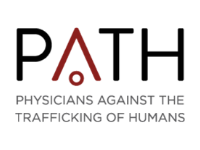 More than 100,000 children are sex trafficked each year in the United States. While each case is different, the median age for children recruited into sex trafficking is 14-17 years old, with some victims as young as seven. Often emergency rooms are used to treat trafficked individuals, making it crucial for emergency medical personnel to be able to recognize and offer the appropriate treatment and resources in these critical situations.
More than 100,000 children are sex trafficked each year in the United States. While each case is different, the median age for children recruited into sex trafficking is 14-17 years old, with some victims as young as seven. Often emergency rooms are used to treat trafficked individuals, making it crucial for emergency medical personnel to be able to recognize and offer the appropriate treatment and resources in these critical situations.
Physicians Against the Trafficking of Humans (PATH), founded by the American Medical Women’s Association in 2014, developed the specific curriculum Learn to Identify & Fight Trafficking (LIFT), in the effort to educate physicians, residents, and medical students about issues surrounding human trafficking.
This year, ACOEP’s Committee for Women in Emergency and PATH are teaming up and hosting the special CME-eligible track at the 2019 Scientific Assembly in Austin, TX on Monday, November 4th from 3-6pm. All Scientific Assembly attendees are encouraged to attend.
“The goals of the AMWA-PATH presentation are to be able to recognize the public health implications of all forms of human trafficking, the medical and psychiatric consequences of being trafficked, clinical red flags clinicians should be aware of when working to identify victims when they seek services in the emergency room, and referral pathways and reporting requirements,” Mollie Gordon, MD, a co-chair of the program said.
Manipulation and abuse are just two of the many scenarios in which victims are often mistreated while being trafficked. Dr. Gordon explains that common misconceptions regarding human trafficking include the ideas that victims can “leave whenever they want, that sex work is a choice, and that smuggling and trafficking are the same.”
Complications of a treatable disease, repetitive stress injuries, physical or sexual assaults, and STI’s, are some of the most common red flags when presented with cases of sex trafficking victims. Through the LIFT curriculum, attendees will learn more about the different scenarios in which physicians should be aware of when treating a patient who is being trafficked.
While there are specific procedures and resources emergency medical personnel utilize when treating a sex-trafficked patient, Dr. Gordon reminds us that the main task at hand with these cases is to “treat patients in a trauma informed manner.”
“Our job is to not separate patients from their traffickers. Patients know when it is safest to leave their situation,” she said.
To learn more about how to treat sex-trafficked patients in your ED, we invite you to attend ACOEP’s Committee for Women in Emergency Medicine’s Track at the 2019 Scientific Assembly on Monday, November 4th, from 3pm-6pm.

Leave A Comment
You must be logged in to post a comment.